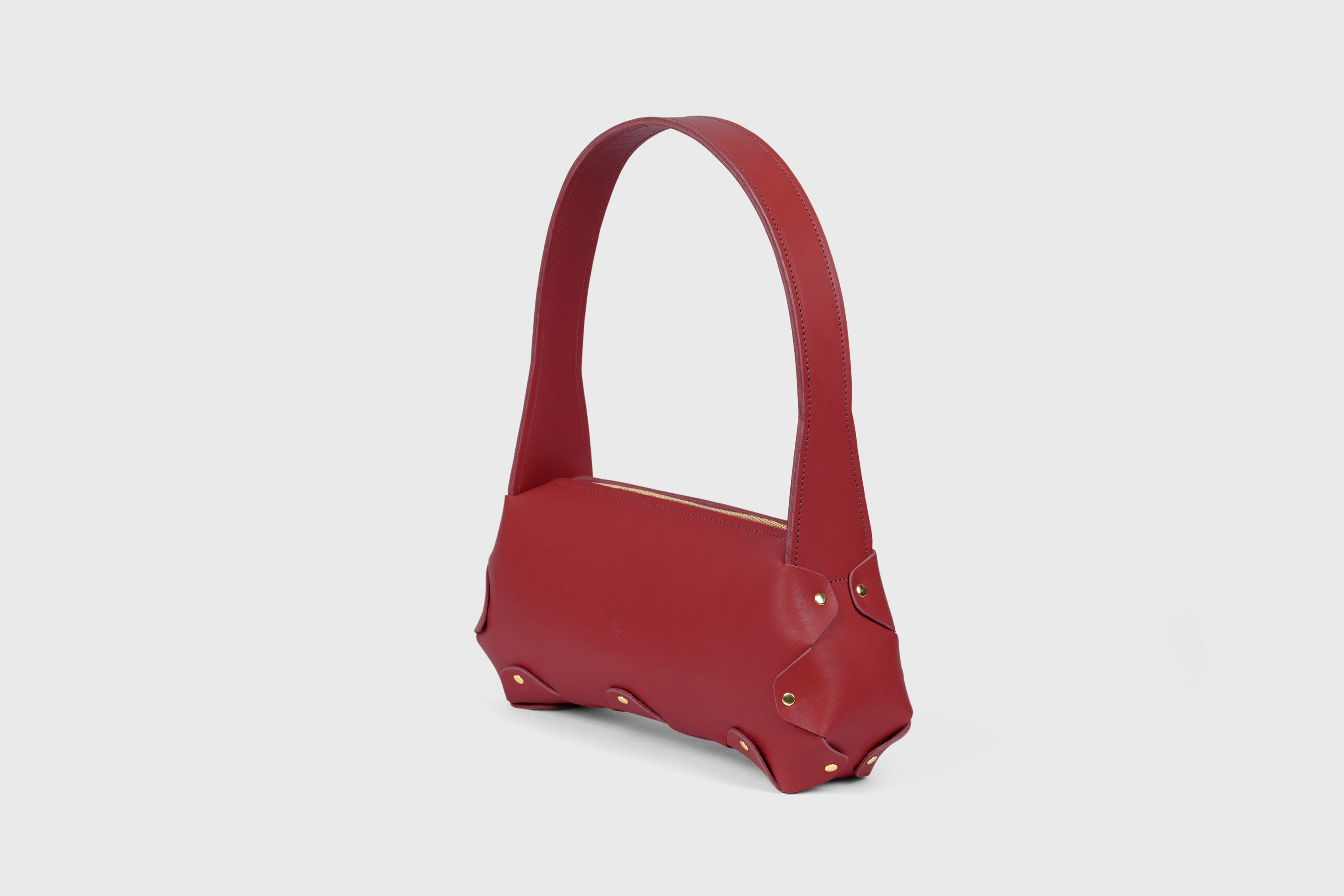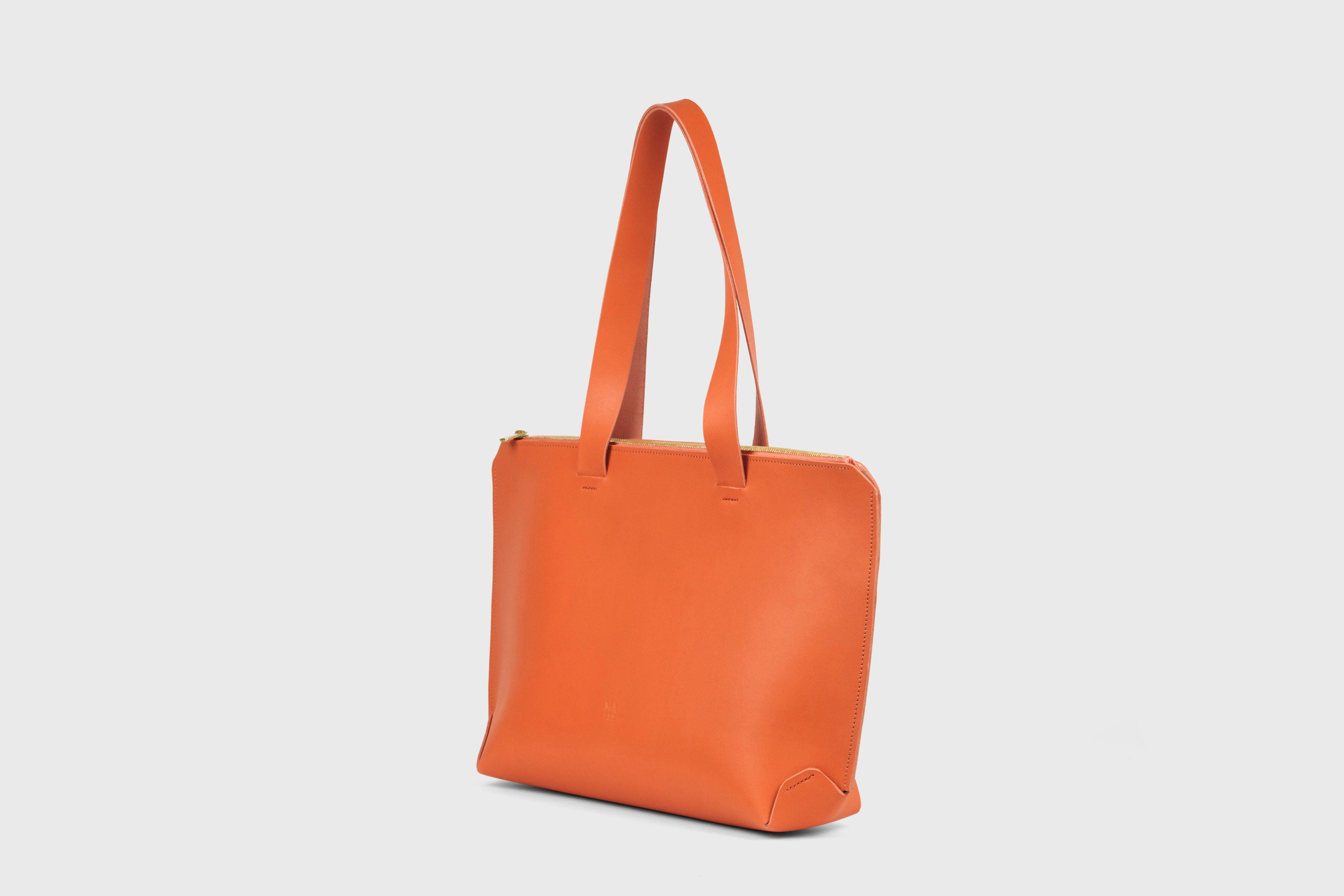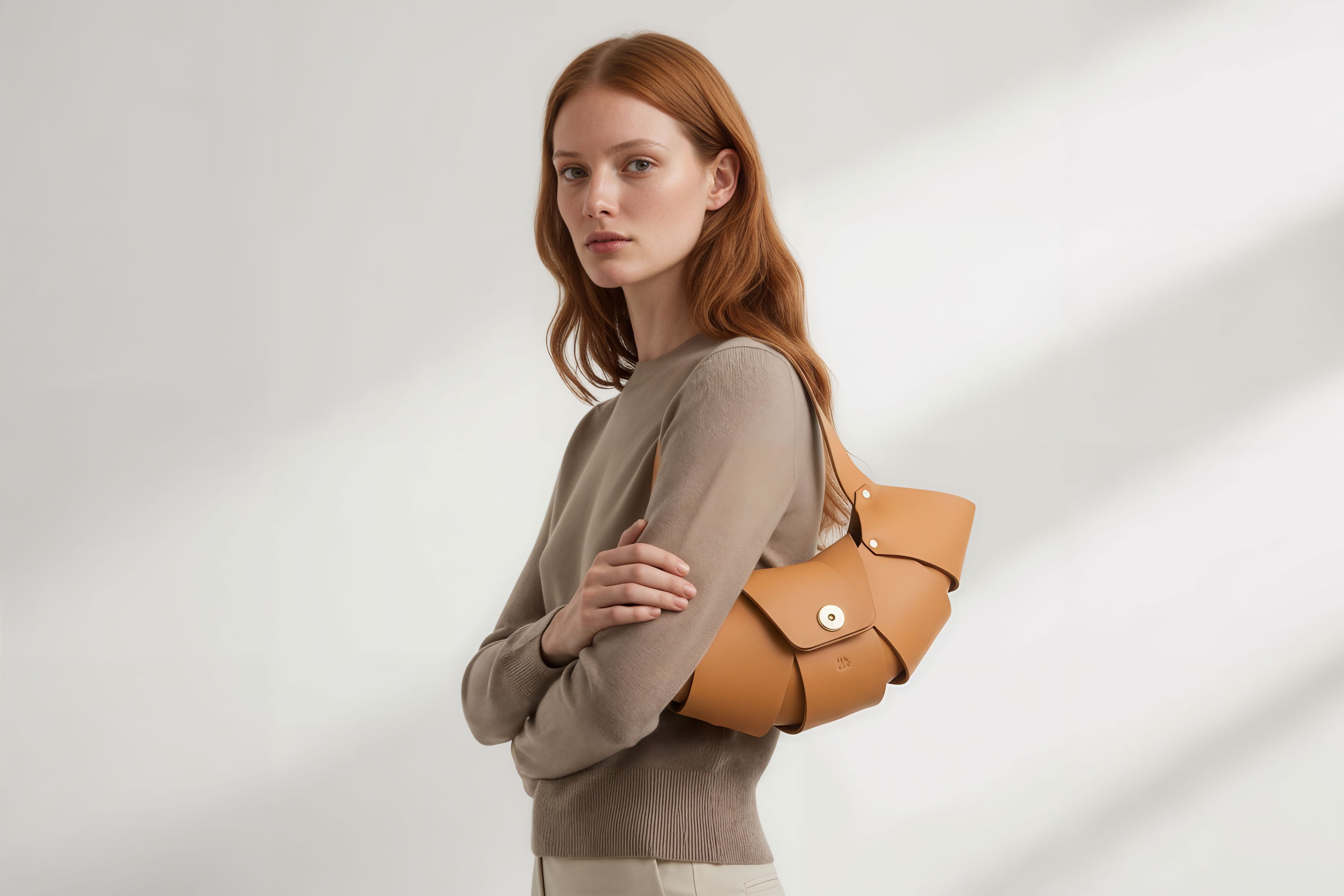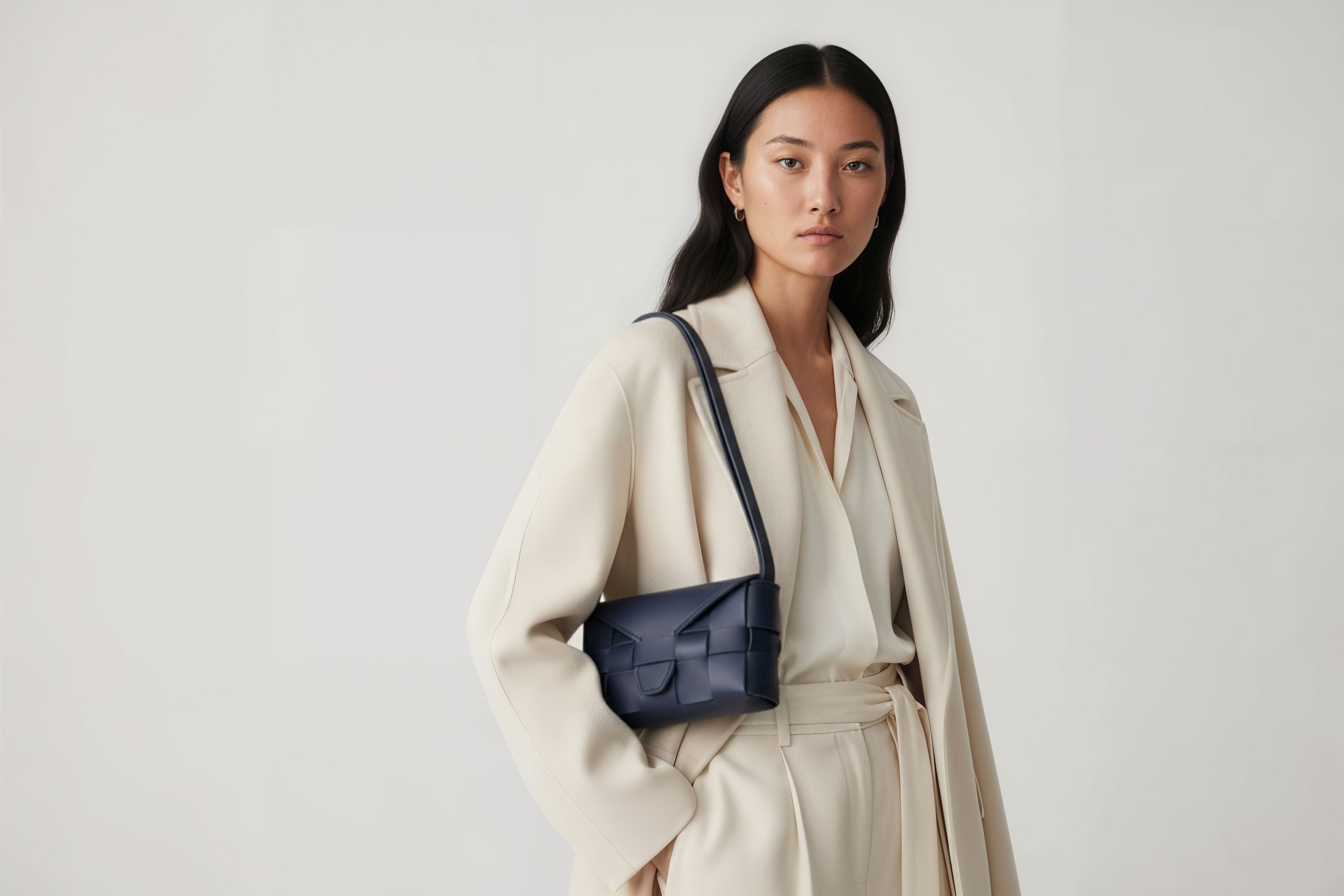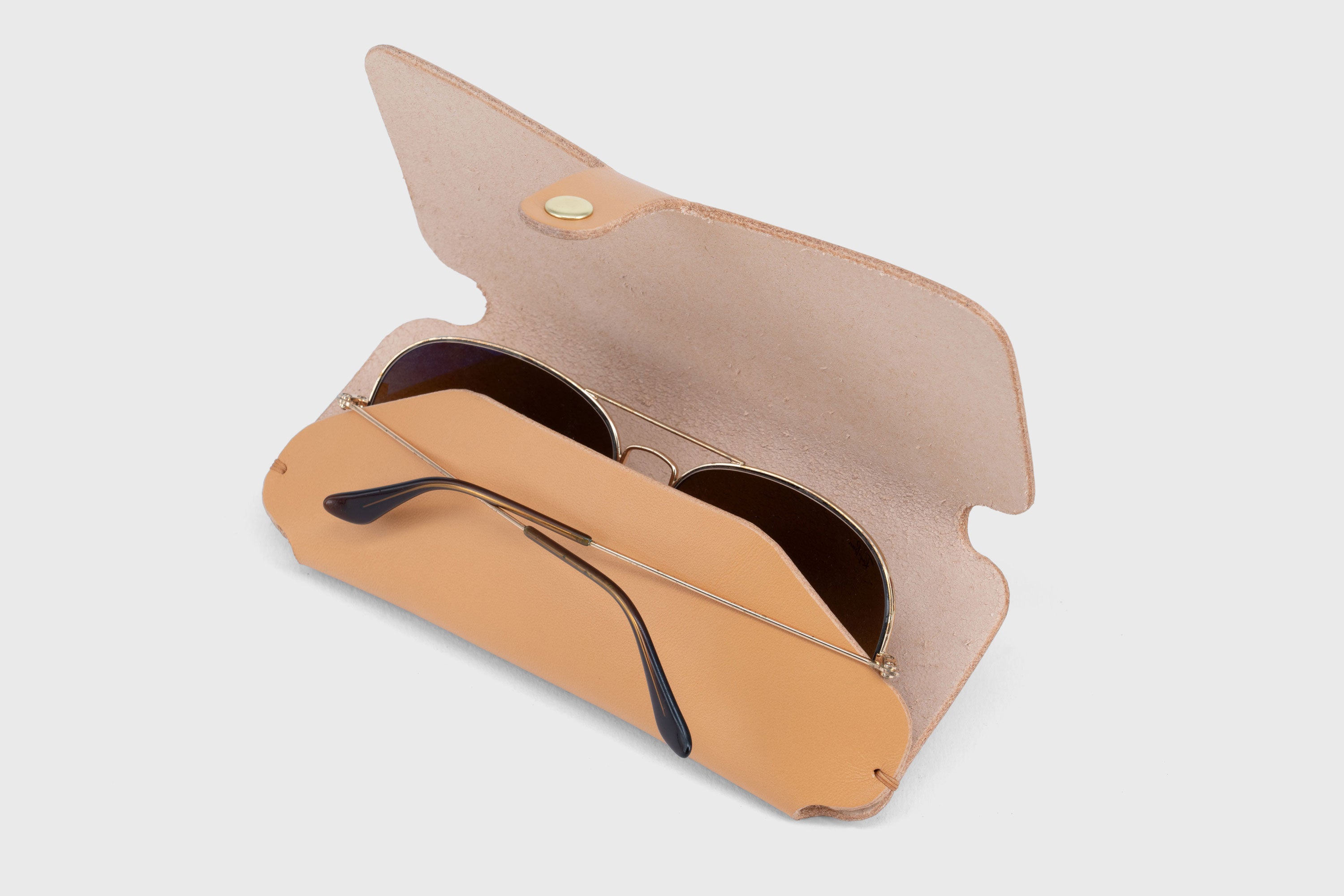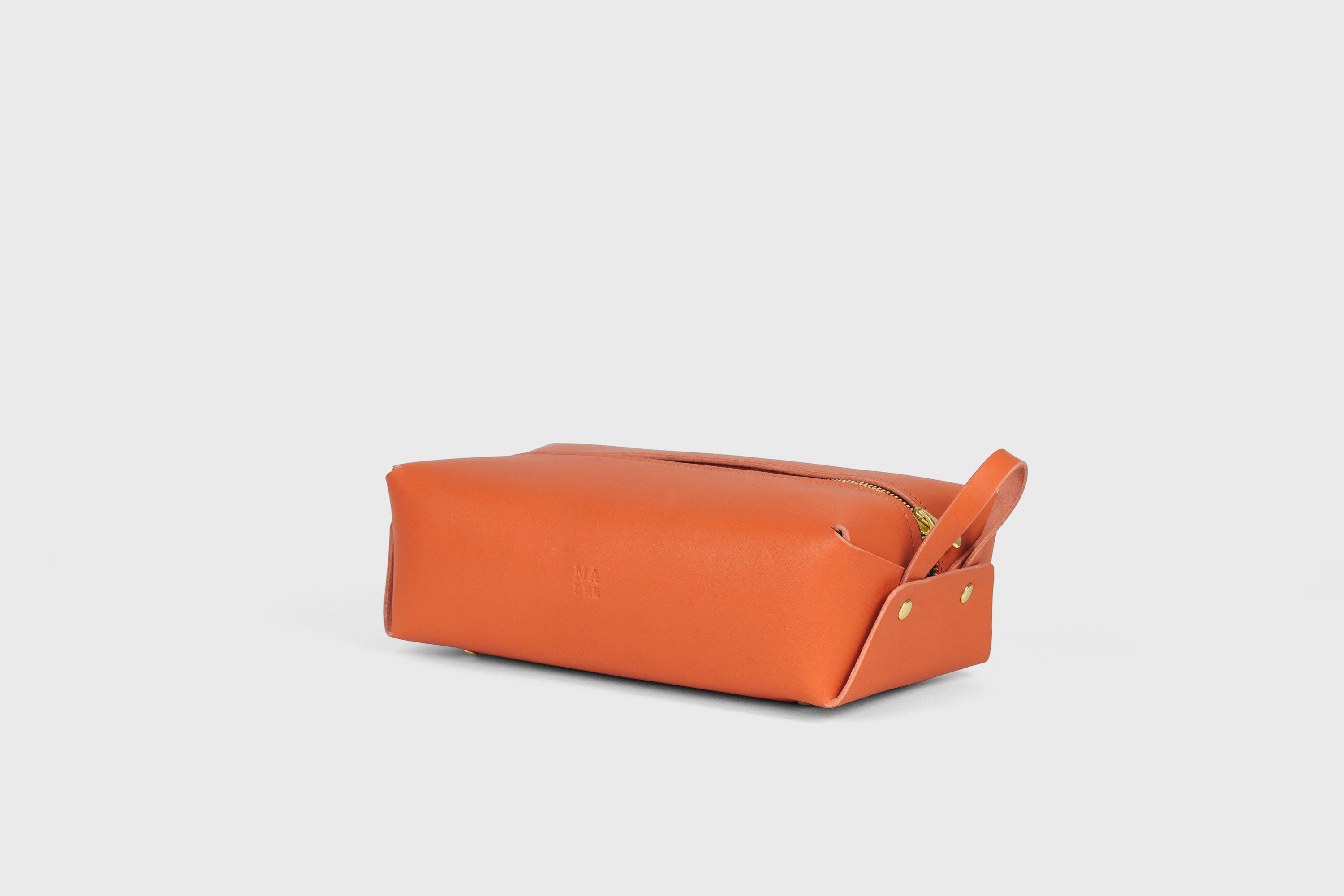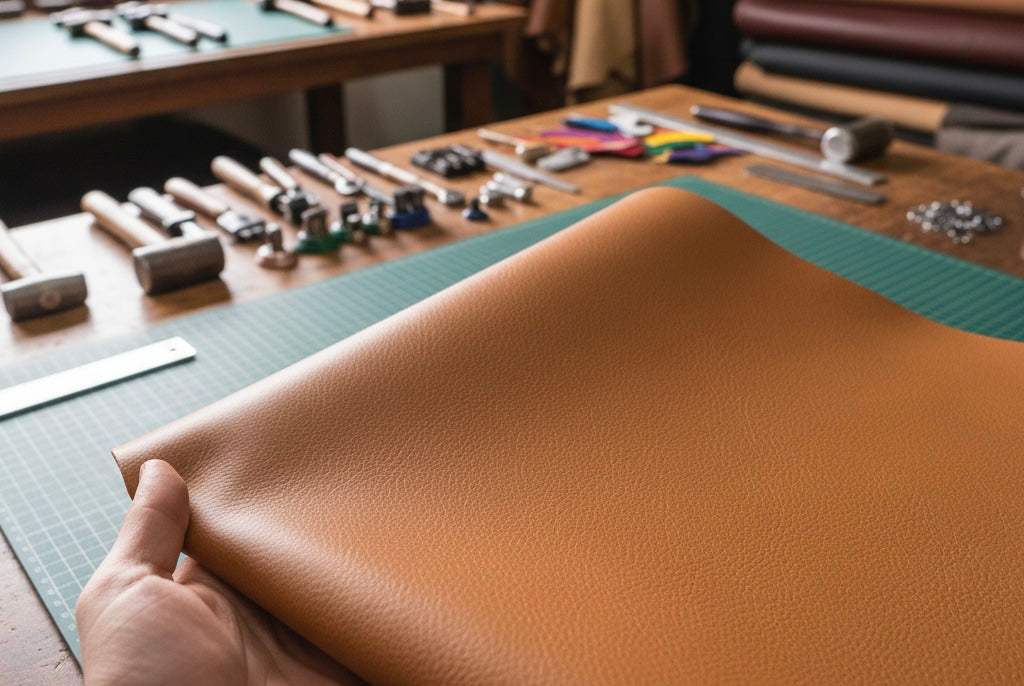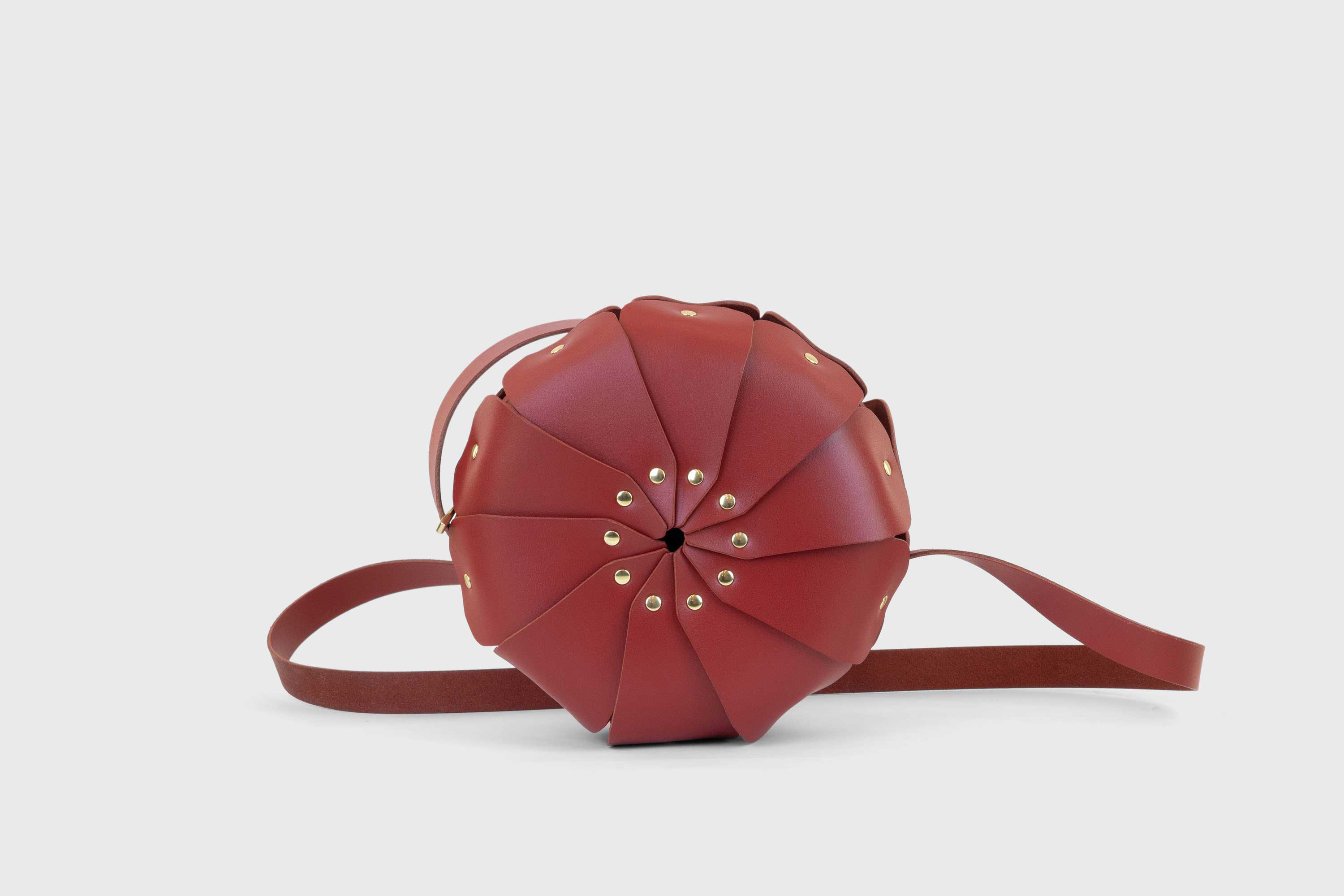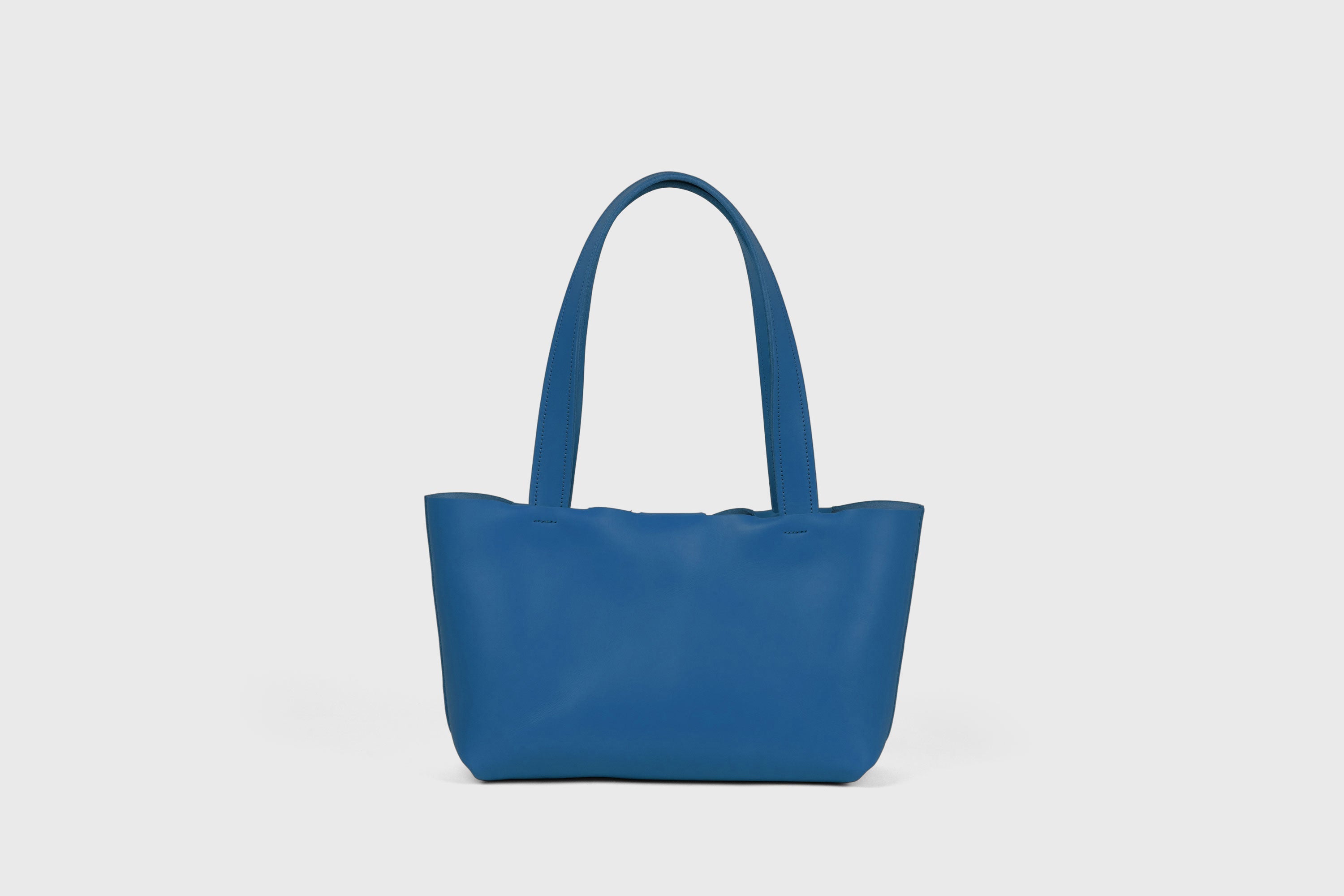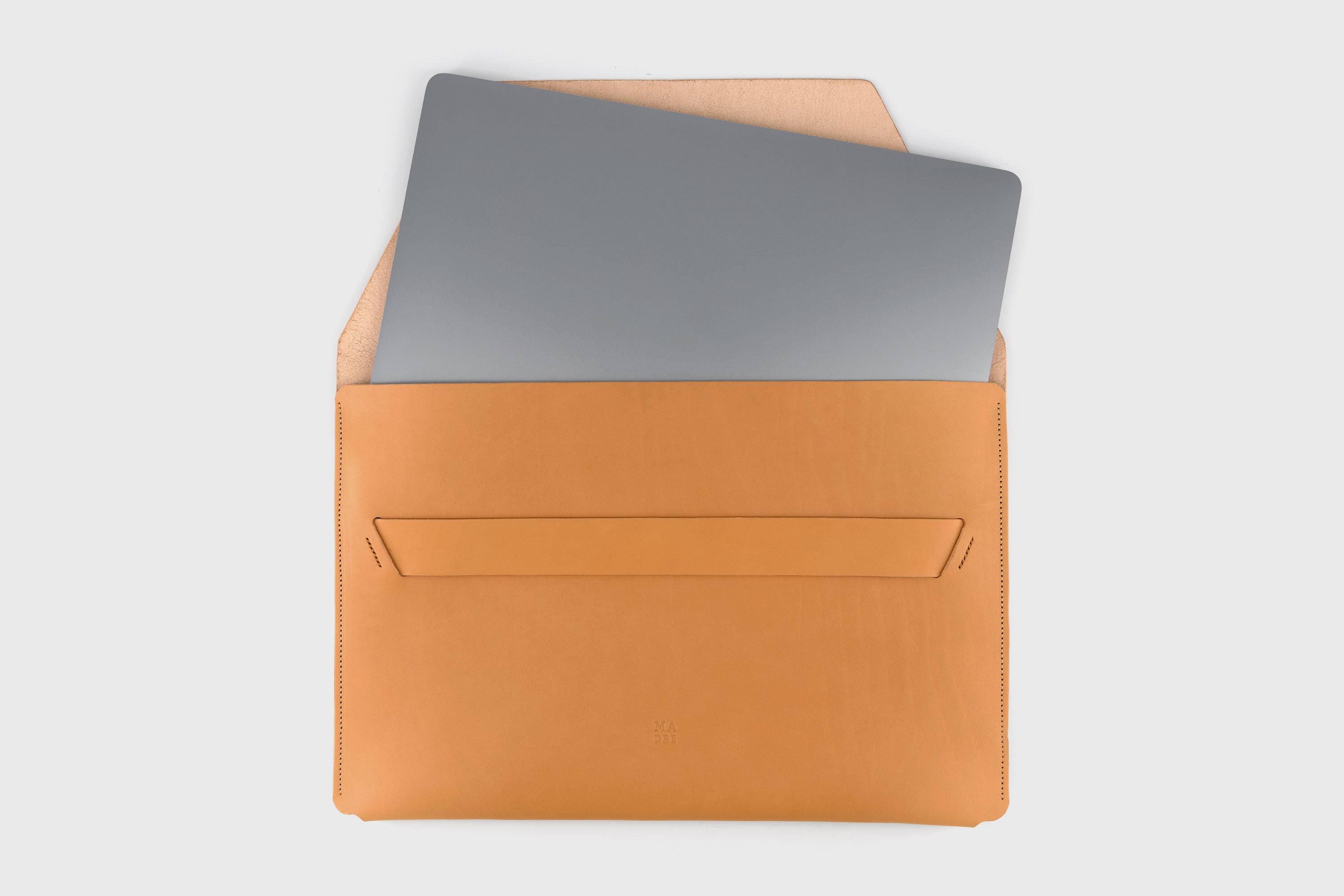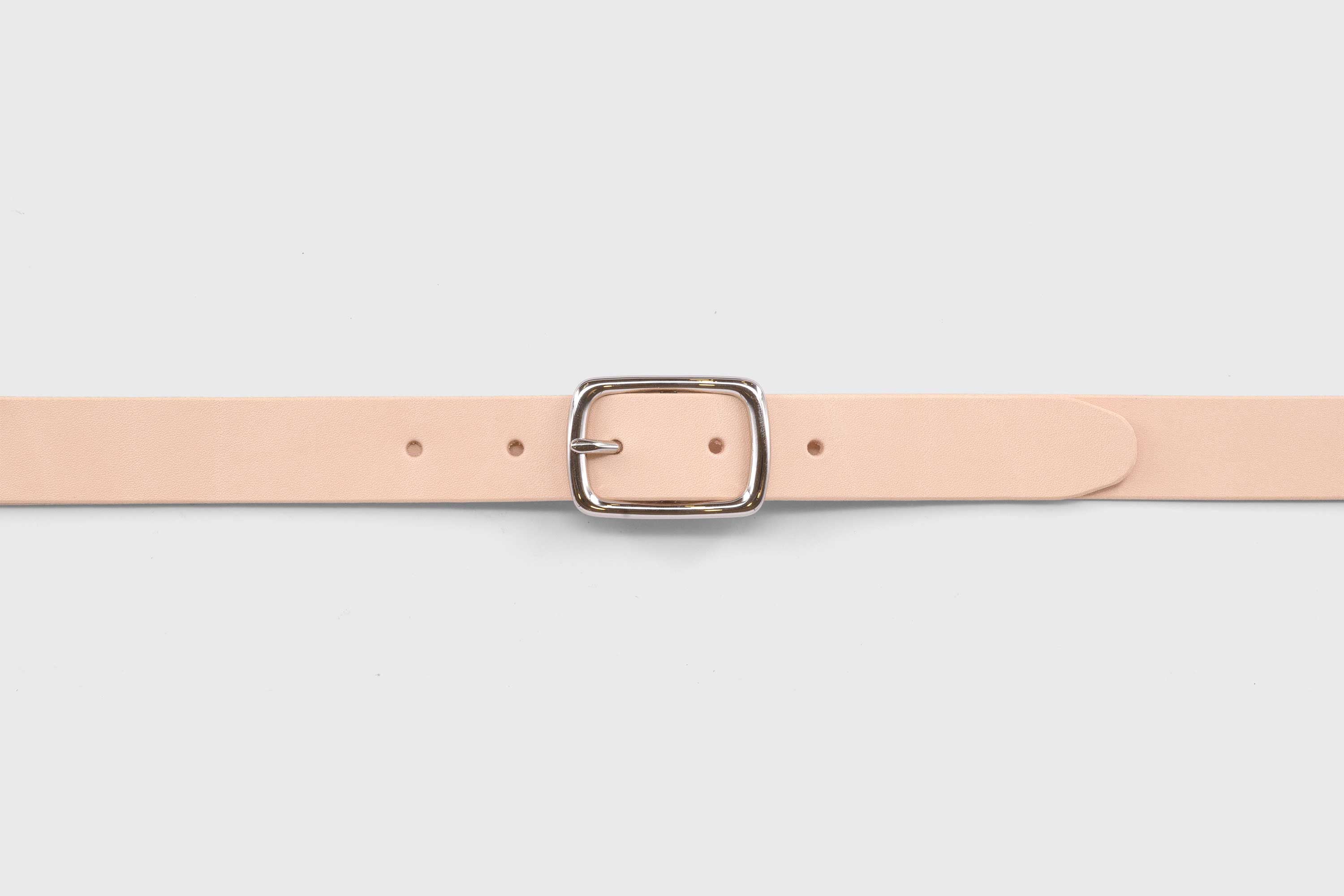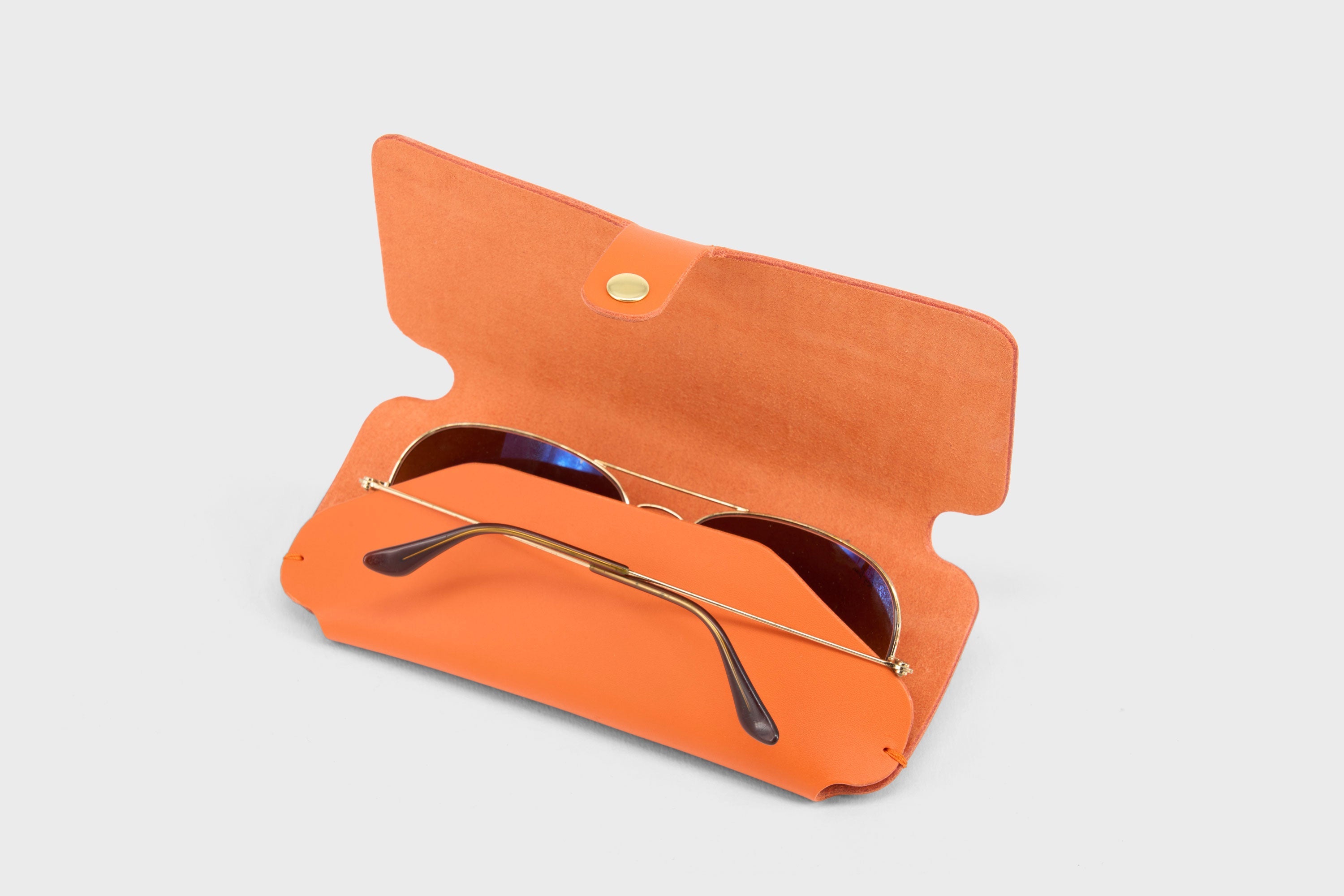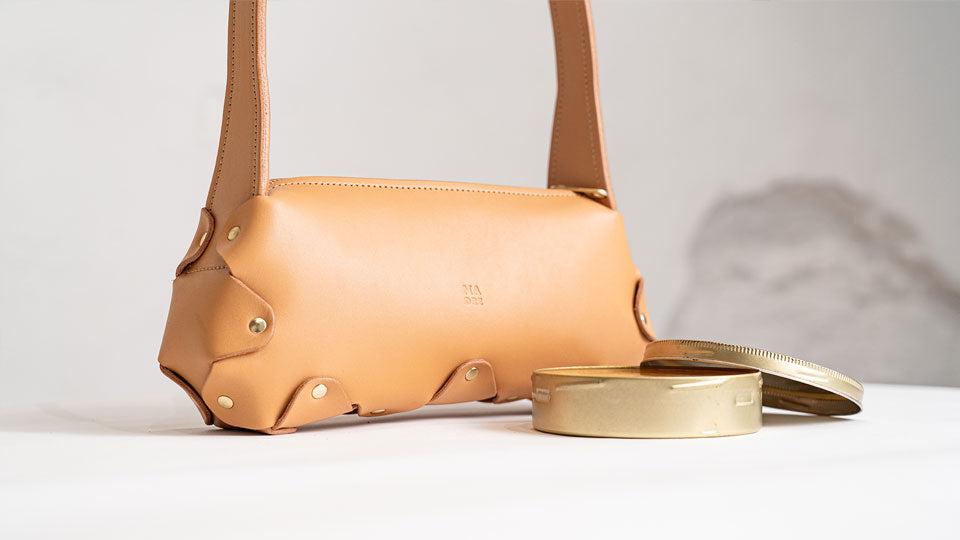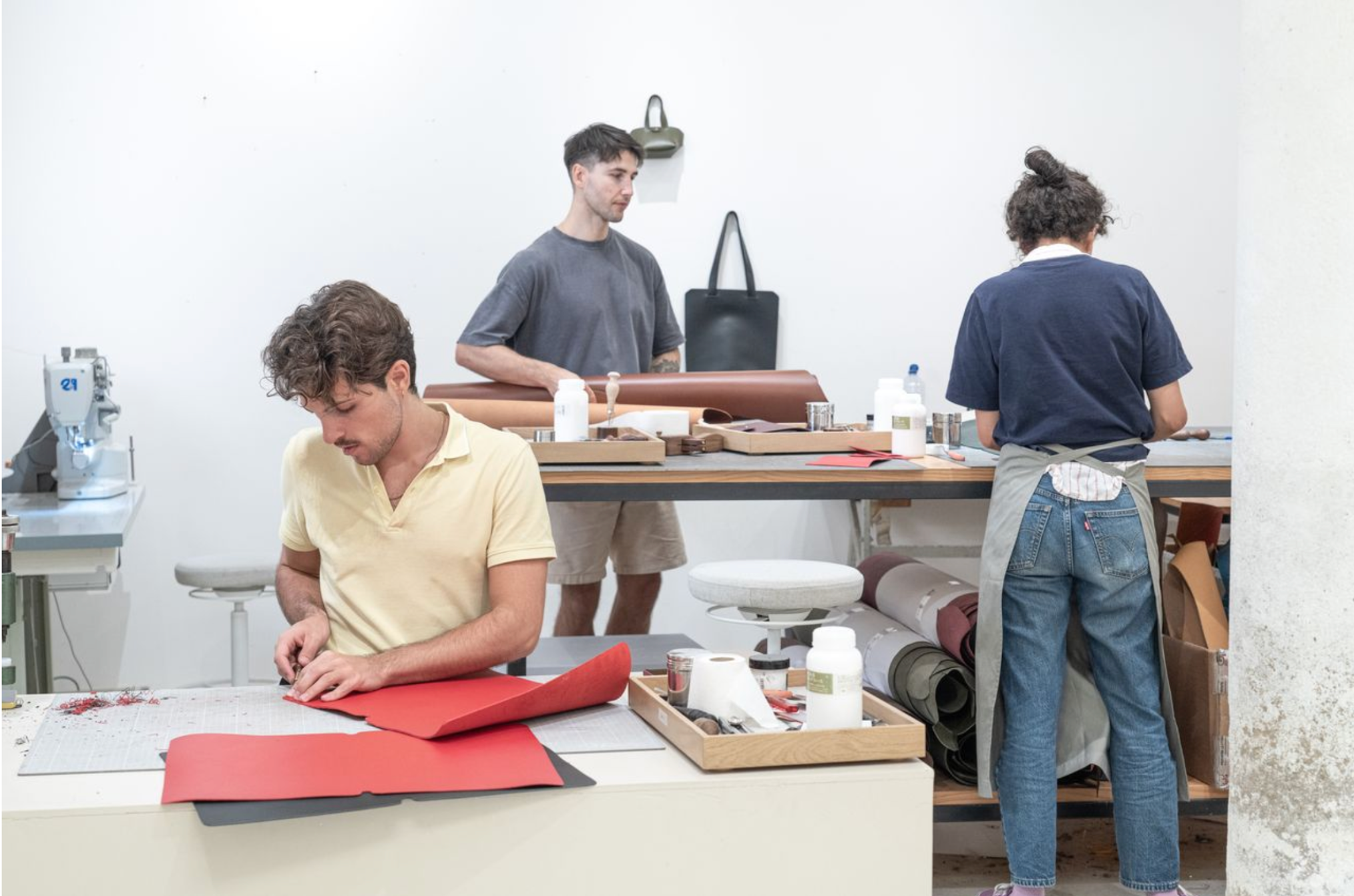Swift leather is a full grain calfskin with a smooth, fine surface and a naturally soft temper. The grain is untouched, so nothing is sanded or embossed. This keeps the tiny, even pores of high quality calf leather visible and gives Swift its refined, clean appearance.
The tanning process plays a central role in the way Swift behaves. It is chrome tanned, a method that preserves flexibility and allows the leather to absorb colour with exceptional consistency. This is why Swift is often associated with vivid, even tones. The finish applied on the surface is deliberately thin. It protects the leather while keeping its natural look visible, avoiding the artificial shine that appears on heavily coated leathers.
What sets Swift apart is its balance between softness and structure. The leather bends easily without losing its shape and its smooth surface remains stable in use. The grain is authentic, the texture is subtle and the overall look remains calm and understated.
Because of these characteristics, Swift is often chosen for pieces that require a refined, even surface without sacrificing the natural qualities of the hide. It offers a combination of consistency, softness and genuine grain that is uncommon in modern smooth leathers.
The History of Swift Leather
Swift leather evolved from an earlier fine grain calfskin known as Gulliver. In 1990, Gulliver was valued for its tight grain, chrome tannage, soft temper and smooth natural surface. Production stopped in 1999 because only a small share of calf hides met the required grain quality and seasonal yields were too inconsistent.
From 2000 to 2005, improvements in retanning chemistry, fatliquors, dye systems and milling equipment made it possible to reproduce the same fine grain finish with more reliable results. Stricter hide selection also helped.
In 2005, the material returned under the name Swift. The leather remained essentially the same. Swift, Gulliver and Jonathan belong to the same internal naming family, all referencing the author Jonathan Swift. Swift is simply the modern continuation of the original Gulliver concept.
How Is Swift Leather Made?
The production of Swift leather follows a precise method that keeps the grain untouched while developing the softness and colour it is known for.
Step 1: Selecting the Hides
Choosing the Right Calfskins
Swift begins with young calfskins that naturally have tight fibers and very small pores. Because smooth leather reveals every detail on its surface, only hides with exceptionally even grain are chosen. This early selection ensures the leather will not require sanding or correction, which is essential for preserving the fine natural texture that defines Swift.
Why Grain Matters
Swift's clean look depends on grain uniformity. Any variation becomes visible on a smooth surface, so selecting hides with minimal marking is critical. This is why Swift always appears refined and even, without the texture interruptions found in pebbled or corrected leathers.
Step 2: Tanning the Leather
Chrome Tanning
Swift leather is chrome tanned. This method stabilizes the hide while keeping it soft, flexible and light in weight. Chrome tanning also supports a broad and precise colour range, allowing Swift to carry both soft neutrals and vivid shades with exceptional clarity. Compared with vegetable tanning, chrome tanning gives Swift better resistance to everyday moisture and prevents the material from becoming overly stiff.
Adding Oils After Tanning
Once tanning is complete, a carefully measured blend of oils and conditioning agents is added. This restores suppleness lost during processing and is responsible for the smooth, soft handfeel Swift is known for. The balance is important. Too much oil would leave the surface greasy, while too little would reduce flexibility.
Step 3: Milling the Leather
Relaxing the Fibers
The hides are placed into large milling drums, where gentle motion helps the fibers relax. This step gives Swift its natural drape. It softens the internal structure without removing the leather's integrity.
Creating the Swift Temper
Milling produces Swift's signature temper. It is soft enough to move comfortably, yet structured enough to avoid collapsing completely. This is why bags made from Swift feel fluid and easy to carry, but still present a clean silhouette.
Step 4: Finishing the Surface
Minimal Pigment Application
Swift is finished with a very thin layer of pigment. The goal is to achieve even colour while keeping the natural grain visible. Because the coating is so light, Swift retains a matte to soft satin surface that never looks coated or artificial.
Light Protective Coat
A subtle protective layer is added to guard against everyday handling. This layer is intentionally minimal, preserving the feel of real calfskin rather than covering it with heavy films. It provides protection while allowing the leather to age naturally.
Step 5: The Final Material
When finished, Swift leather has a smooth, refined surface with extremely fine grain and excellent colour clarity. It feels soft in the hand, bends easily and shows a quiet sheen as it ages. The leather retains its natural look because nothing in the process is designed to disguise or alter its grain. Instead, Swift is created to highlight the qualities of high grade calfskin. Clean texture, soft movement and a surface that stays elegant without appearing coated.

How Does Swift Leather Perform in Daily Use?
Is Swift leather long lasting?
Yes. Swift is made from dense calf fibers, which hold strength even though the leather feels soft. With normal handling and basic care, it remains stable and durable for many years.
Does Swift leather scratch easily?
Yes. The surface is smooth, so any mark is easier to see. Light scratches often soften with warmth from the hand. Deeper marks remain visible. This is typical for smooth leather.
Is Swift leather waterproof?
No. It is chrome tanned, so it resists moisture better than vegetable tanned leather, but it is not waterproof. Light rain is usually fine. Full saturation should be avoided.
Does Swift leather lose its shape?
Only in unstructured designs. Swift has a soft temper, so it drapes naturally. When a bag has internal structure, it keeps its form. The leather itself does not collapse without reason. The design determines the shape.
Does Swift leather soften over time?
Yes. It starts soft and becomes smoother with use. The change is subtle rather than dramatic. It does not develop a heavy patina.
Does Swift leather change colour?
Very little. Chrome tanning produces stable colour. Bright tones stay vivid and neutrals stay clean. Prolonged sunlight can fade any leather, including Swift, but the effect is slow.
How does Swift leather handle everyday use overall?
Swift is comfortable to carry and light in the hand. It softens with wear, but does not peel or flake because it is not coated with heavy films. It tolerates daily handling well, but the smooth surface shows scratches more quickly than textured leathers. It will not look tired quickly if treated with reasonable care, yet it will show signs of use earlier than pebbled leather because the grain is completely smooth.
Swift Leather Compared with Other Leathers
Swift Leather and Pebbled Leather
Swift has a smooth, fine surface that shows marks easily. Pebbled leather hides wear because its textured grain breaks up the appearance of scratches and pressure points. For a clearer breakdown of how these surfaces behave, see Pebbled vs Smooth Leather.
Swift feels soft and flexible. Pebbled leather has more body and keeps its shape with less internal support.
Colour appears sharper on Swift because the grain is small and consistent. Pebbled leather softens the appearance slightly because the raised pattern scatters light.
Swift suits a clean, refined finish. Pebbled leather is easier to manage day to day.

Swift Leather and Vegetable Tanned Leather
Swift is chrome tanned, so it begins soft and stays close to its original colour. Vegetable tanned leather behaves differently. It starts firm, softens slowly and develops a strong, natural patina. You can learn more in our guide to Vegetable Tanned Leather.
Vegetable tanned leather has one clear advantage. It becomes richer and more characterful with age. The colour deepens, the surface records use and the material gains personality that smooth chrome tanned leathers do not show. It also holds structure well, making it suitable for pieces that need firmness.
At Atelier Madre, we use vegetable tanned leather when long term aging and structure matter. Swift is used when softness, lightness and colour clarity are the priority.

Swift Leather and Faux Leather
Swift is natural calfskin with real fiber depth. Faux leather is a synthetic coating placed on a fabric base. This difference affects everything. Swift softens, breathes and matures. Faux leather often cracks or peels once the surface coating wears. For a closer look, see Faux Leather Unveiled.
Swift feels warm and comfortable to the touch. Faux leather has very low breathability and often feels cooler or rubbery. Swift can be restored by a leather specialist. Faux leather cannot return to its original condition once the coating fails.
Swift is built for long term everyday use. Faux leather is better suited for short life cycles or seasonal trends.

Swift Leather and Togo Leather
Swift and Togo come from the same family of calf leathers, but they behave differently. Swift has a smooth surface that presents colour with precision. Togo has a clear, pebbled grain that hides small marks and gives the leather a more practical look. You can explore this texture more deeply in Togo Leather Our Complete Guide.
Swift is soft and flexible. It follows the movement of the bag. Togo has more internal structure and holds its shape with less reinforcement.
Swift develops a gentle surface sheen with use. Togo changes slowly and keeps its grain for many years. Swift feels lighter in the hand because it has a thin finish. Togo feels more substantial due to its grain pattern and firmer temper.

Pros and Cons of Swift Leather
| Pros | Cons |
| Soft and comfortable from the first use | Shows scratches easily because of the smooth surface |
| Clear and even colour presentation | Needs gentle handling to avoid visible marks |
| Light in weight and easy to carry | Offers limited structure without internal support |
| Develops a subtle sheen with time | Not suitable for heavy rain or full water exposure |
| Bends naturally and works well for relaxed designs | Does not develop a strong patina over time |
Swift leather is soft from the beginning, so it feels comfortable the moment you start using it. It is also light in weight, which makes it easy to carry throughout the day. The smooth surface shows colour beautifully, so tones look clear and even rather than textured or muted. As the leather is used, the finish becomes slightly smoother and develops a gentle polish, adding refinement without altering the overall look.
Swift does need a little more attention than textured leathers. Its smooth grain makes small marks easier to see, so it suits someone who enjoys keeping their pieces in good condition and prefers a polished look. If you like the idea of a bag that feels soft in the hand and shows colour in a clean, uninterrupted way, Swift is a very good fit. If you prefer something that hides wear almost completely or feels a bit more forgiving day to day, another leather with more texture will be easier to live with.
Swift also has a softer structure, which allows a bag to drape slightly rather than stand upright on its own. This quality is perfect for designs meant to feel more flexible and easygoing. If a firm, structured shape is important, another type of calf leather with more body may be the better choice. Swift handles light moisture without difficulty, but it is not designed for heavy rain or prolonged exposure to water.
In terms of aging, Swift remains close to its original appearance over time. It does not darken or develop a strong patina the way vegetable tanned leather does. Instead, it ages quietly, gaining smoothness and subtle sheen rather than dramatic colour changes.
How to Take Care of Swift Leather

Cleaning
Swift leather should be cleaned with a soft dry cloth to remove everyday dust. When the surface needs a little more attention, a very small amount of gentle leather lotion can be used, but only when applied to the cloth rather than directly onto the leather. Heavy conditioners and wax based products are not suitable because they leave residue on smooth finishes and can make Swift look coated rather than natural.
Handling Scratches
Light scratches on Swift usually soften with warmth from your fingertips as the surface relaxes slightly. Any marks that remain visible should be handled gently, as rubbing too firmly can flatten the fine grain. When a scratch is deeper or more noticeable, a leather specialist can blend pigment in a thin, controlled way that keeps the surface looking even.
Managing Moisture
Swift tolerates light rain without trouble, but it should not be soaked. If the leather becomes wet, the safest approach is to let it dry naturally at room temperature. Placing it near heaters or using a hairdryer can cause the fibers to harden and may leave the leather stiff or uneven.
Protection
Smooth leather shows friction and transfer more easily than textured leathers, so Swift should be kept away from rough surfaces such as stone or brick. Dark denim and strongly dyed fabrics can leave marks if they rub repeatedly against the leather. Long hours of direct sunlight should also be avoided because strong light slowly fades the colour.
Storage
Swift keeps its softness and shape best when stored upright and lightly filled, allowing the form to rest without collapsing. A breathable dust bag is ideal because it protects the leather while preventing trapped moisture. High humidity, heat and tightly packed spaces should be avoided to keep the surface smooth and the structure stable.
Who Does Swift Leather Suit?
Swift suits someone who prefers a smooth surface, a soft handfeel and colour that stays stable with time. It is a chrome tanned leather, so it feels comfortable from the first use and works well in pieces designed to stay light and relaxed rather than firm or sharply structured.
Vegetable tanned leather sits on the other end of the spectrum. It begins firm, holds its shape with confidence and gains visual depth as it softens through use. People who value structure, long term stability and a more natural evolution often prefer vegetable tanned materials even if they are not directly comparable to chrome tanned leathers like Swift.
If your priority is structure and a natural, long lasting feel, you can explore our bags and accessories made with vegetable tanned leather.
Frequently Asked Questions
Is Swift leather real leather?
Yes. Swift leather is full grain calfskin, which is the highest grade of natural leather. The grain layer is intact, meaning the surface has not been sanded, corrected or embossed. This is why Swift shows very fine pores, even color and a smooth, natural surface.
Does Swift leather scratch easily?
Yes. Swift has a smooth surface, so marks show more quickly than on textured leathers. Light scratches usually soften with warmth from the fingertips as the surface relaxes. Deeper marks remain visible because smooth leathers cannot hide abrasion the way pebbled leathers do. This is normal for any high-grade smooth calfskin.
Is Swift leather durable for everyday use?
Yes. Even though it feels soft, Swift is cut from dense calf fibers, which makes it strong and stable. It performs best when the bag has some internal structure. Completely unstructured bags will drape, but that is the design, not a failure of the material.
Does Swift leather lose its shape?
Only in designs that have no internal support. Swift has a naturally soft temper and will follow the movement of the bag. Structured bags stay in shape because the leather has enough internal strength. Soft bags will relax over time.
Does Swift leather change color or develop a patina?
Very little. Swift is chrome tanned, so its color stays stable. It develops a gentle surface sheen, not a deep patina. This is the main difference between Swift and vegetable tanned leather, which darkens and gains visible character over time.
Is Swift leather water resistant?
Swift tolerates light rain because chrome tanning stabilizes the fibers. However, it is not waterproof. Heavy rain, soaking or standing water can cause temporary swelling or marks. If wet, it should be left to dry naturally away from heat.
How do you clean and maintain Swift leather?
Use a soft dry cloth for everyday cleaning. If needed, apply a very small amount of mild leather lotion to a cloth, not directly onto the leather. Avoid waxes, heavy conditioners and oils because they leave residue on smooth finishes and make Swift look coated.
Does Swift leather peel or crack over time?
No. Swift does not have a thick coating, so there is no synthetic film to peel. Cracking happens only when leather becomes extremely dry or is exposed to strong heat. With normal use and occasional conditioning, Swift remains smooth and flexible.


